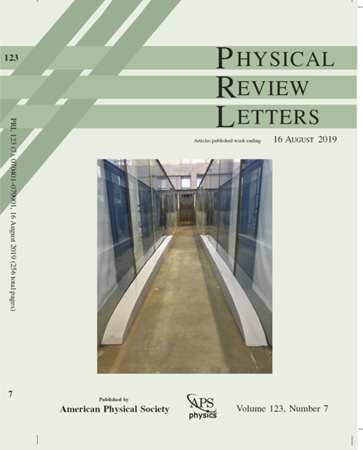Tunable Generation of Spatial Entanglement in Nonlinear Waveguide Arrays
IF 9
1区 物理与天体物理
Q1 PHYSICS, MULTIDISCIPLINARY
引用次数: 0
Abstract
Harnessing high-dimensional entangled states of light presents a frontier for advancing quantum information technologies, from fundamental tests of quantum mechanics to enhanced computation and communication protocols. In this context, the spatial degree of freedom stands out as particularly suited for on-chip integration. But while traditional demonstrations produce and manipulate path-entangled states sequentially with discrete optical elements, continuously coupled nonlinear waveguide systems offer a promising alternative where photons can be generated and interfere along the entire propagation length, unveiling novel capabilities within a reduced footprint. Here we exploit this concept to implement a compact and reconfigurable source of path-entangled photon pairs based on parametric down-conversion in semiconductor nonlinear waveguide arrays. We use a double-pump configuration to engineer the output quantum state and implement various types of spatial correlations, exploiting a quantum interference effect between the biphoton state generated in each pumped waveguide. This demonstration, at room temperature and telecom wavelength, illustrates the potential of continuously coupled systems as a promising alternative to discrete multicomponent quantum circuits for leveraging the high-dimensional spatial degree of freedom of photons.非线性波导阵列中空间纠缠的可调谐产生
利用光的高维纠缠态是推进量子信息技术的前沿,从量子力学的基本测试到增强的计算和通信协议。在这种情况下,空间自由度特别适合片上集成。但是,虽然传统的演示使用离散光学元件顺序产生和操纵路径纠缠态,但连续耦合非线性波导系统提供了一个有前途的替代方案,可以在整个传播长度上产生光子并进行干涉,从而在更小的占地面积内揭示出新的功能。本文利用这一概念在半导体非线性波导阵列中实现了一种基于参数下转换的紧凑且可重构的路径纠缠光子对源。我们使用双泵浦配置来设计输出量子态并实现各种类型的空间相关性,利用每个泵浦波导中产生的双光子态之间的量子干涉效应。这个在室温和电信波长下的演示,说明了连续耦合系统作为离散多分量量子电路的一种有前途的替代方案的潜力,可以利用光子的高维空间自由度。2024年由美国物理学会出版
本文章由计算机程序翻译,如有差异,请以英文原文为准。
求助全文
约1分钟内获得全文
求助全文
来源期刊

Physical review letters
物理-物理:综合
CiteScore
16.50
自引率
7.00%
发文量
2673
审稿时长
2.2 months
期刊介绍:
Physical review letters(PRL)covers the full range of applied, fundamental, and interdisciplinary physics research topics:
General physics, including statistical and quantum mechanics and quantum information
Gravitation, astrophysics, and cosmology
Elementary particles and fields
Nuclear physics
Atomic, molecular, and optical physics
Nonlinear dynamics, fluid dynamics, and classical optics
Plasma and beam physics
Condensed matter and materials physics
Polymers, soft matter, biological, climate and interdisciplinary physics, including networks
 求助内容:
求助内容: 应助结果提醒方式:
应助结果提醒方式:


